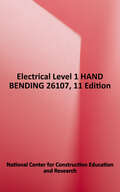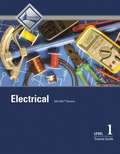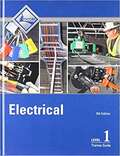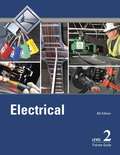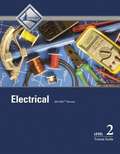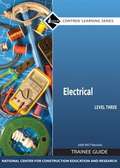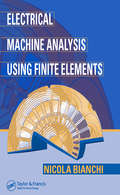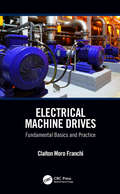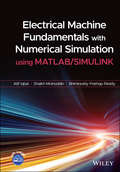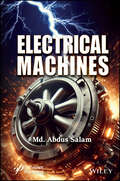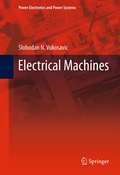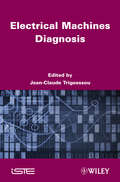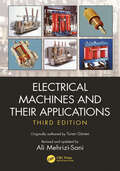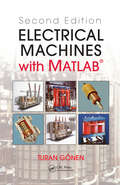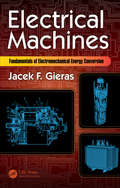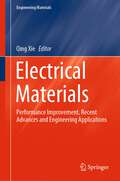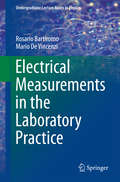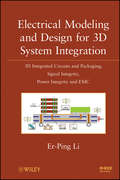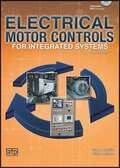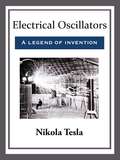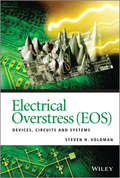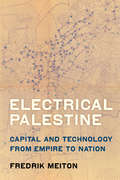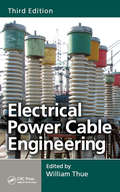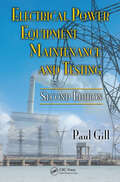- Table View
- List View
Electrical Level 1 Hand Bending Eleventh Edition
by National Center for Construction Education and ResearchElectrical, Level 1, introduces core facets of the electrical trade. This first level of a four-part series covers foundational industry knowledge. Throughout the series, you'll gain a comprehensive understanding of the structure of electrical systems while learning how to follow blueprints, install wiring, and navigate electrical components. This first level addresses the basics of occupational safety, electrical circuits and theory, electrical codes, tools and techniques, construction documents, residential wiring, and electrical test equipment. The 11th Edition aligns with the most up-to-date electrical codes. All modules have been rewritten to be more concise and easier to read. A new, modern layout and art style reflect the latest tools, methods, technologies, and best practices.
Electrical Level 1 Trainee Guide (Eighth Edition)
by Nccer<P>This exceptionally produced trainee guide features a highly illustrated design, technical hints and tips from industry experts, review questions and a whole lot more!<P> Key content includes:<P> Orientation to the Electrical Trade, Electrical Safety, Introduction to Electrical Circuits, Electrical Theory, Introduction to the National Electrical Code, Device Boxes, Hand Bending, Raceways and Fittings, Conductors and Cables, Basic Electrical Construction Drawings, Residential Electrical Services, and Electrical Test Equipment.
Electrical Level 1: Trainee Guide
by NccerThis exceptionally produced trainee guide features a highly illustrated design, technical hints and tips from industry experts, review questions and a whole lot more! Key content includes: Orientation to the Electrical Trade, Electrical Safety, Introduction to Electrical Circuits, Electrical Theory, Introduction to the National Electrical Code, Device Boxes, Hand Bending, Raceways and Fittings, Conductors and Cables, Basic Electrical Construction Drawings, Residential Electrical Services, and Electrical Test Equipment.
Electrical Level 2 Trainee Guide
by NccerThis exceptionally produced trainee guide features a highly illustrated design, technical hints and tips from industry experts, review questions and a whole lot more! Key content includes: Alternating Current, Motors: Theory and Application, Electric Lighting, Conduit Bending, Pull and Junction Boxes, Conductor Installations, Cable Tray, Conductor Terminations and Splices, Grounding and Bonding, Circuit Breakers and Fuses, Control Systems and Fundamental Concepts.
Electrical Level 2 Trainee Guide (Eighth Edition)
by NccerThis exceptionally produced trainee guide features a highly illustrated design, technical hints and tips from industry experts, review questions and a whole lot more! Key content includes: Alternating Current, Motors: Theory and Application, Electric Lighting, Conduit Bending, Pull and Junction Boxes, Conductor Installations, Cable Tray, Conductor Terminations and Splices, Grounding and Bonding, Circuit Breakers and Fuses, Control Systems and Fundamental Concepts.
Electrical Level 3 Trainee Guide
by NccerThis exceptionally produced trainee guide features a highly illustrated design, technical hints and tips from industry experts, review questions and a whole lot more! Key content includes: Load Calculations – Branch Feeders and Circuits, Conductor Selection and Calculations, Practical Applications of Lighting, Hazardous Locations, Overcurrent Protection, Distribution Equipment, Transformers, Commercial Electrical Services, Motor Calculations, Voice, Data, and video and Motor Controls.
Electrical Machine Analysis Using Finite Elements (Power Electronics and Applications Series #8)
by Nicola Bianchi<p>From the fan motor in your PC to precision control of aircraft, electrical machines of all sizes, varieties, and levels of complexity permeate our world. Some are very simple, while others require exacting and application-specific design. Electrical Machine Analysis Using Finite Elements provides the tools necessary for the analysis and design of any type of electrical machine by integrating mathematical/numerical techniques with analytical and design methodologies. <p>Building successively from simple to complex analyses, this book leads you step-by-step through the procedures and illustrates their implementation with examples of both traditional and innovative machines. Although the examples are of specific devices, they demonstrate how the procedures apply to any type of electrical machine, introducing a preliminary theory followed by various considerations for the unique circumstance. The author presents the mathematical background underlying the analysis, but emphasizes application of the techniques, common strategies, and obtained results. He also supplies codes for simple algorithms and reveals analytical methodologies that universally apply to any software program. <p>With step-by-step coverage of the fundamentals and common procedures, Electrical Machine Analysis Using Finite Elements offers a superior analytical framework that allows you to adapt to any electrical machine, to any software platform, and to any specific requirements that you may encounter.</p>
Electrical Machine Drives: Fundamental Basics and Practice
by Claiton Moro FranchiThis work was developed based on the author's experience of more than 10 years working in research and industry in the areas of electrical drives and industrial automation. Seeking the connection between theory and its applications, the author presents a detailed conceptual description with lots of figures and illustrative examples that harmonize the theoretical approach with the practice. Composed of eleven chapters and three appendices, the book describes in a dynamic and didactic way the fundamental concepts related to the drives of electric machines. At the end of each chapter is a set of exercises to ease the fixation of the presented content.
Electrical Machine Fundamentals with Numerical Simulation using MATLAB / SIMULINK
by Atif Iqbal Shaikh Moinoddin Bhimireddy Prathap ReddyA comprehensive text, combining all important concepts and topics of Electrical Machines and featuring exhaustive simulation models based on MATLAB/Simulink Electrical Machine Fundamentals with Numerical Simulation using MATLAB/Simulink provides readers with a basic understanding of all key concepts related to electrical machines (including working principles, equivalent circuit, and analysis). It elaborates the fundamentals and offers numerical problems for students to work through. Uniquely, this text includes simulation models of every type of machine described in the book, enabling students to design and analyse machines on their own. Unlike other books on the subject, this book meets all the needs of students in electrical machine courses. It balances analytical treatment, physical explanation, and hands-on examples and models with a range of difficulty levels. The authors present complex ideas in simple, easy-to-understand language, allowing students in all engineering disciplines to build a solid foundation in the principles of electrical machines. This book: Includes clear elaboration of fundamental concepts in the area of electrical machines, using simple language for optimal and enhanced learning Provides wide coverage of topics, aligning with the electrical machines syllabi of most international universities Contains extensive numerical problems and offers MATLAB/Simulink simulation models for the covered machine types Describes MATLAB/Simulink modelling procedure and introduces the modelling environment to novices Covers magnetic circuits, transformers, rotating machines, DC machines, electric vehicle motors, multiphase machine concept, winding design and details, finite element analysis, and more Electrical Machine Fundamentals with Numerical Simulation using MATLAB/Simulink is a well-balanced textbook perfect for undergraduate students in all engineering majors. Additionally, its comprehensive treatment of electrical machines makes it suitable as a reference for researchers in the field.
Electrical Machines
by Md. Abdus SalamElectrical Machines is essential for anyone in the engineering field, as it provides comprehensive coverage of electrical machines and practical skills in analysis and simulation, making it an invaluable resource for students, educators, and industry professionals alike. This outstanding new volume covers the basics of electrical machines, including analysis and simulation using Automation Studio and Multisim software. Written by an expert in the field, this is a must-have for any mechanical engineer’s library, covering three-phase power, electromagnetic circuits, transformers, DC generators and DC motors, three-phase induction motors, synchronous generators and motors, single-phase induction motors, special motors, controls, and much more. Not just for the practicing engineer, this is a valuable reference work for the student, teacher, or other industry professional.
Electrical Machines
by Slobodan N. VukosavicElectrical Machines primarily covers the basic functionality and the role of electrical machines in their typical applications. The effort of applying coordinate transforms is justified by obtaining a more intuitive, concise and easy-to-use model. In this textbook, mathematics is reduced to a necessary minimum, and priority is given to bringing up the system view and explaining the use and external characteristics of machines on their electrical and mechanical ports. Covering the most relevant concepts relating to machine size, torque and power, the author explains the losses and secondary effects, outlining cases and conditions in which some secondary phenomena are neglected. While the goal of developing and using machine mathematical models, equivalent circuits and mechanical characteristics persists through the book, the focus is kept on physical insight of electromechanical conversion process. Details such as the slot shape and the disposition of permanent magnets and their effects on the machine parameters and performance are also covered.
Electrical Machines Diagnosis
by Jean-Claude TrigeassouMonitoring and diagnosis of electrical machine faults is a scientific and economic issue which is motivated by objectives for reliability and serviceability in electrical drives. This book provides a survey of the techniques used to detect the faults occurring in electrical drives: electrical, thermal and mechanical faults of the electrical machine, faults of the static converter and faults of the energy storage unit. Diagnosis of faults occurring in electrical drives is an essential part of a global monitoring system used to improve reliability and serviceability. This diagnosis is performed with a large variety of techniques: parameter estimation, state observation, Kalman filtering, spectral analysis, neural networks, fuzzy logic, artificial intelligence, etc. Particular emphasis in this book is put on the modeling of the electrical machine in faulty situations. Electrical Machines Diagnosis presents original results obtained mainly by French researchers in different domains. It will be useful as a guideline for the conception of more robust electrical machines and indeed for engineers who have to monitor and maintain electrical drives. As the monitoring and diagnosis of electrical machines is still an open domain, this book will also be very useful to researchers.
Electrical Machines and Their Applications
by Ali Mehrizi-SaniThis popular, easy-to-read book offers a comprehensive yet unique treatment of electrical machines and their historical development. Electrical Machines and Their Applications, Third Edition covers an in-depth analysis of machines augmented with ample examples, which makes it suitable for both those who are new to electric machines and for those who want to deepen their knowledge of electric machines. This book provides a thorough discussion of electrical machines. It starts by reviewing the basics of concepts needed to fully understand the machines, e.g., three-phase circuits and fundamentals of energy conversion, and continues to discuss transformers, induction machines, synchronous machines, dc machines, and other special machines and their dynamics. This natural progression creates a unifying theme and helps the reader appreciate how the same physical laws of energy conversion govern the operation and dynamics of different machine types. The text is sprinkled with ample examples to further solidify the discussed concepts. Several well-placed appendices make the book self-contained and even easier to follow. This book is part of a series on power system topics originally authored by the late Turan Gönen. The book has been edited by Ali Mehrizi-Sani to bring it up to date while maintaining its original charm. Both new and seasoned readers for Gönen’s books will find this new edition a much-awaited update to the second edition.
Electrical Machines with MATLAB
by Turan GonenElectrical Machines with MATLAB encapsulates the invaluable insight and experience that eminent instructor Turan Gonen has acquired in almost 40 years of teaching. With simple, versatile content that separates it from other texts on electrical machines, this book is an ideal self-study tool for advanced students in electrical and other areas of eng
Electrical Machines: Fundamentals of Electromechanical Energy Conversion
by Jacek F. GierasThis book endeavors to break the stereotype that basic electrical machine courses are limited only to transformers, DC brush machines, induction machines, and wound-field synchronous machines. It is intended to serve as a textbook for basic courses on Electrical Machines covering the fundamentals of the electromechanical energy conversion, transformers, classical electrical machines, i.e., DC brush machines, induction machines, wound-field rotor synchronous machines and modern electrical machines, i.e., switched reluctance machines (SRM) and permanent magnet (PM) brushless machines. In addition to academic research and teaching, the author has worked for over 18 years in US high-technology corporative businesses providing solutions to problems such as design, simulation, manufacturing and laboratory testing of large variety of electrical machines for electric traction, energy generation, marine propulsion, and aerospace electric systems.
Electrical Materials: Performance Improvement, Recent Advances and Engineering Applications (Engineering Materials)
by Peng Wang Jun Xie Yiyi ZhangThis book highlights the latest advances in advanced insulating materials. Energy crisis and environmental pollution are two major themes currently faced by the human society. It is of unprecedented strategic importance to construct a strong smart grid with super/ultra-high voltage network as the backbone and clean energy transmission as the leading force. However, the performance of electrical equipment and devices is greatly determined by the properties of their insulating materials, especially when they have to work in extreme circumstances including high-temperature differences, intense radiation, and strong electric fields. The key advantage of polymers is that their properties could be adjusted by changing their chemical composition and molecular structure. Research on polymer insulating materials has been highly successful as progress has been made in characterizing these properties, designing molecular structures, and studying polymers’ specialized properties. On the other hand, nanodielectrics are prepared by adding certain nanoscale fillers into a polymer matrix to yield better electrical, thermal, and mechanical properties. When the particle pretreatment methods and the content or category of fillers are adjusted, nanodielectrics tend to have greater breakdown strength as well as better high-temperature resistance and space charge suppression. Therefore, this book covers investigations of properties of insulating materials that explore their interface effects and composite structures and introduces findings in methods that improve the performance of electrical devices. The book is not only used as a timely reference for engineering and technical personnel in related fields but also as a comprehensive textbook for college students.
Electrical Measurement Techniques: For the Physics Laboratory
by Lars BengtssonThis book highlights the electrical engineering aspects of a typical physics laboratory. To perform a sound experiment in a physics laboratory, it is paramount that readers understand the equipment and methods used to collect the data. This includes sensors (e.g., thermocouples and vacuum gauges), amplifiers (e.g., instrumentation amplifiers and lock-in amplifiers), oscilloscopes and probes (active probes and current probes), transmission cables (50-ohm termination) and noise shielding (grounding), spectrum analyzers (FFT and heterodyne technique), ADCs and digital signal processing, convolution and correlation, data analysis such as curve fitting, and uncertainty calculations (uncertainty ‘budgets’). The readers need to know about electromagnetic crosstalk, time-to-digital converters, student-t distributions, PID controllers, spectral leakage, and windows. This book helps readers understand all of that.
Electrical Measurements in the Laboratory Practice
by Rosario Bartiromo Mario De VincenziThis book covers thebasic theory of electrical circuits, describes analog and digitalinstrumentation, and applies modern methods to evaluate uncertainties in electricalmeasurements. It is comprehensive in scope and is designed specifically to meetthe needs of students in physics and electrical engineering who are attendinglaboratory classes in electrical measurements. The topics addressed inindividual chapters include the analysis of continuous current circuits;sources of measurement uncertainty and their combined effect; direct currentmeasurements; analysis of alternating current circuits; special circuitsincluding resonant circuits, frequency filters and impedance matchingnetworks; alternating current measurements; analog and digital oscilloscopes;non-sinusoidal waveforms and circuit excitation by pulses; distributedparameter components and transmission lines. Each chapter is equipped with anumber of problems. A special appendixdescribes a series of nine experiments, in each case providing a plan of actionfor students and guidance for tutors to assist in the preparation andillustration of the experiment.
Electrical Modeling and Design for 3D System Integration
by Er-Ping LiNew advanced modeling methods for simulating the electromagnetic properties of complex three-dimensional electronic systems Based on the author's extensive research, this book sets forth tested and proven electromagnetic modeling and simulation methods for analyzing signal and power integrity as well as electromagnetic interference in large complex electronic interconnects, multilayered package structures, integrated circuits, and printed circuit boards. Readers will discover the state of the technology in electronic package integration and printed circuit board simulation and modeling. In addition to popular full-wave electromagnetic computational methods, the book presents new, more sophisticated modeling methods, offering readers the most advanced tools for analyzing and designing large complex electronic structures. Electrical Modeling and Design for 3D System Integration begins with a comprehensive review of current modeling and simulation methods for signal integrity, power integrity, and electromagnetic compatibility. Next, the book guides readers through: The macromodeling technique used in the electrical and electromagnetic modeling and simulation of complex interconnects in three-dimensional integrated systems The semi-analytical scattering matrix method based on the N-body scattering theory for modeling of three-dimensional electronic package and multilayered printed circuit boards with multiple vias Two- and three-dimensional integral equation methods for the analysis of power distribution networks in three-dimensional package integrations The physics-based algorithm for extracting the equivalent circuit of a complex power distribution network in three-dimensional integrated systems and printed circuit boards An equivalent circuit model of through-silicon vias Metal-oxide-semiconductor capacitance effects of through-silicon vias Engineers, researchers, and students can turn to this book for the latest techniques and methods for the electrical modeling and design of electronic packaging, three-dimensional electronic integration, integrated circuits, and printed circuit boards.
Electrical Motor Controls for Integrated Systems
by Glen A. Mazur Gary RockisElectrical Motor Controls for Integrated Systems is the industry-leading textbook covering electrical, motor, and mechanical devices and their use in automated systems and industrial control circuits. Topics are organized into sections for modular instruction and can easily be used in seminars and in online educational settings. This edition includes motor control and integrated systems technology for instruction of advanced manufacturing skills. The industry practices complement the advancing technology of motor starters, motor drives, PLCs, semiconductors, and control devices. Essential troubleshooting procedures are integrated into each chapter, and electrical safety has been expanded throughout.
Electrical Oscillators
by Nikola TeslaNikola Tesla was a genius who revolutionized how the world looks at electricity. In 1893 he patented an electro-mechanical oscillator as a steam-powered electric generator. By his own account, one version of the oscillator caused an earthquake in New York City in 1898, for which it was accorded the moniker, "Tesla's earthquake machine."
Electrical Overstress (EOS)
by Steven H. VoldmanElectrical Overstress (EOS) continues to impact semiconductor manufacturing, semiconductor components and systems as technologies scale from micro- to nano-electronics. This bookteaches the fundamentals of electrical overstress and how to minimize and mitigate EOS failures. The text provides a clear picture of EOS phenomena, EOS origins, EOS sources, EOS physics, EOS failure mechanisms, and EOS on-chip and system design. It provides an illuminating insight into the sources of EOS in manufacturing, integration of on-chip, and system level EOS protection networks, followed by examples in specific technologies, circuits, and chips. The book is unique in covering the EOS manufacturing issues from on-chip design and electronic design automation to factory-level EOS program management in today's modern world.Look inside for extensive coverage on:Fundamentals of electrical overstress, from EOS physics, EOS time scales, safe operating area (SOA), to physical models for EOS phenomenaEOS sources in today's semiconductor manufacturing environment, and EOS program management, handling and EOS auditing processing to avoid EOS failuresEOS failures in both semiconductor devices, circuits and systemDiscussion of how to distinguish between EOS events, and electrostatic discharge (ESD) events (e.g. such as human body model (HBM), charged device model (CDM), cable discharge events (CDM), charged board events (CBE), to system level IEC 61000-4-2 test events)EOS protection on-chip design practices and how they differ from ESD protection networks and solutionsDiscussion of EOS system level concerns in printed circuit boards (PCB), and manufacturing equipmentExamples of EOS issues in state-of-the-art digital, analog and power technologies including CMOS, LDMOS, and BCDEOS design rule checking (DRC), LVS, and ERC electronic design automation (EDA) and how it is distinct from ESD EDA systemsEOS testing and qualification techniques, andPractical off-chip ESD protection and system level solutions to provide more robust systemsElectrical Overstress (EOS): Devices, Circuits and Systems is a continuation of the author's series of books on ESD protection. It is an essential reference and a useful insight into the issues that confront modern technology as we enter the nano-electronic era.
Electrical Palestine: Capital and Technology from Empire to Nation
by Fredrik MeitonElectricity is an integral part of everyday life—so integral that we rarely think of it as political. In Electrical Palestine, Fredrik Meiton illustrates how political power, just like electrical power, moves through physical materials whose properties govern its flow. At the dawn of the Arab-Israeli conflict, both kinds of power were circulated through the electric grid that was built by the Zionist engineer Pinhas Rutenberg in the period of British rule from 1917 to 1948. Drawing on new sources in Arabic, Hebrew, and several European languages, Electrical Palestine charts a story of rapid and uneven development that was greatly influenced by the electric grid and set the stage for the conflict between Arabs and Jews. Electrification, Meiton shows, was a critical element of Zionist state building. The outcome in 1948, therefore, of Jewish statehood and Palestinian statelessness was the result of a logic that was profoundly conditioned by the power system, a logic that has continued to shape the area until today.
Electrical Power Cable Engineering: Second: Edition, (Power Engineering (Willis) #1)
by William ThueFully updated, Electrical Power Cable Engineering, Third Edition again concentrates on the remarkably complex design, application, and preparation methods required to terminate and splice cables. This latest addition to the CRC Press Power Engineering series covers cutting-edge methods for design, manufacture, installation, operation, and maintenance of reliable power cable systems. It is based largely on feedback from experienced university lecturers who have taught courses on these very concepts. The book emphasizes methods to optimize vital design and installation of power cables used in the interrelated fields of electrical, mechanical, and, to some extent, civil engineering. An in-depth exploration of power cable characteristics and applications, it illustrates the many factors that can hinder real-world cable performance. Content focuses on low and medium voltages, considering that these are used for the majority of cables in service globally. This edition also details techniques for testing shielded power cable systems in the field, demonstrating how conductor material size and design depend on ampacity, voltage regulation, and other factors. Covering everything from manufacturing to testing, this resource will benefit: Cable engineers and technicians (working for investor-owned utilities, rural electric cooperatives, and industrial manufacturers) who need to improve their oversight and understanding of power cables Universities that offer electrical power courses Professionals who must master new power cable terminology, engineering characteristics, and background information that will aid them in their decision making responsibilities The author is a life fellow of the IEEE and one of the original developers of industry standards for cables and accessories. To simplify field fundamentals and techniques for less experienced readers, his book contains new, updated, and expanded chapters and an extensive glossary, in addition to useful references, tables, equations, and photographs. More experienced engineers will appreciate the book’s invaluable updates on the emerging materials, products, and concepts driving their dynamic field.
Electrical Power Equipment Maintenance and Testing (Second Edition)
by Paul GillThe second edition of a bestseller, this definitive text covers all aspects of testing and maintenance of the equipment found in electrical power systems serving industrial, commercial, utility substations, and generating plants. It addresses practical aspects of routing testing and maintenance and presents both the methodologies and engineering basics needed to carry out these tasks. It is an essential reference for engineers and technicians responsible for the operation, maintenance, and testing of power system equipment. Comprehensive coverage includes dielectric theory, dissolved gas analysis, cable fault locating, ground resistance measurements, and power factor, dissipation factor, DC, breaker, and relay testing methods.
